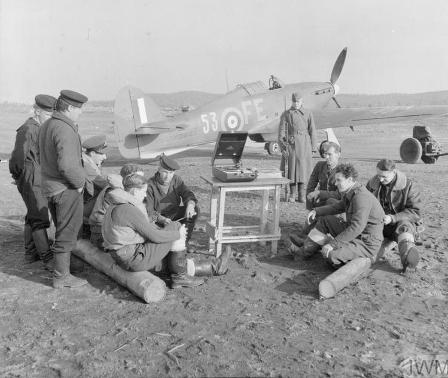Hawker Hurricane

When Nazi Germany launched Operation Barbarossa on 22 June 1941 (the invasion of the Soviet Union) Britain sent its first aid convoy to Murmansk, in North-West Russia, in the first of a series of aid missions which became known as the 'Arctic Convoys'. The convoy carried 40 Hawker Hurricanes, as well as pilots from No. 151 Wing, which comprised of No. 81 Squadron and No. 134 Squadron. Their role was to launch Operation Benedict (29 July- 6 December 1941). Operation Benedict, aimed to deliver Hurricane fighter aircraft to northern ports in the Soviet Union via the Arctic route. The Operation intended to protect the port of Murmansk from air attacks and train Soviet pilots and ground crews on how to operate the Hurricanes.
The Soviets were not always particularly impressed by the Hurricanes. Soviet pilot Vitaly Klimenko stated:
the Hurricane was slow and unwieldy - its wings were too thick1
However, the aircraft had some support, for example Lieutenant Colonel Boris Safonov, twice Hero of the Soviet Union, "loved the Hurricane"2
Despite the conflicted reviews on the Hurricane's performance, Soviet pilots continued to be trained in the aircraft. This was due to the Hurricane performing well in 'horizontal flight' and its ultra-high frequency radio system. The supply of these Lend-Lease Hurricanes also took the strain off the Soviet Aviation Industry, which was struggling under the weight of demand for fighter aircraft and forced to retreat further eastward upon the Nazi invasion of the Soviet Union.
By October 1941 RAF pilots began physically training their Soviet colleagues in how to operate the Hurricanes. By the end of 1941 the RAF had left, however, the Hurricanes remained behind and contributed to the vast number of Allied aircraft operating in the Soviet Union.
No. 151 Wing was led by Wing Commander Neville Ramsbottom Isherwood, who was one of only four British pilots to receive the Order of Lenin, the highest civilian honour bestowed by the Soviet Union. The other three were Squadron Leader Michael Rook, Sergeant Charlton Haw, and Squadron Leader Anthony Miller.
Despite reservations on the proficiency of the Hurricane, it had a significant impact on the course of the War on the Eastern Front. Soviet production of aircraft and other military hardware was waning under the strain of conflict, therefore the material supplied as part of Lend-Lease Act played an important role in sustaining Soviet defence against the Nazis. The supply of Hurricanes also enhanced Soviet-Anglo relations, an alliance that was crucial to defeating Nazi Germany.
1. Jacobs, Peter: 'Hawker Hurricane' (Crowood Press, 1998)
2. Drabkin, Artem: 'Barbarossa and the Retreat to Moscow: Recollections of Soviet Fighter Planes on the Eastern Front' (Pen & Sword Aviation, 2007)